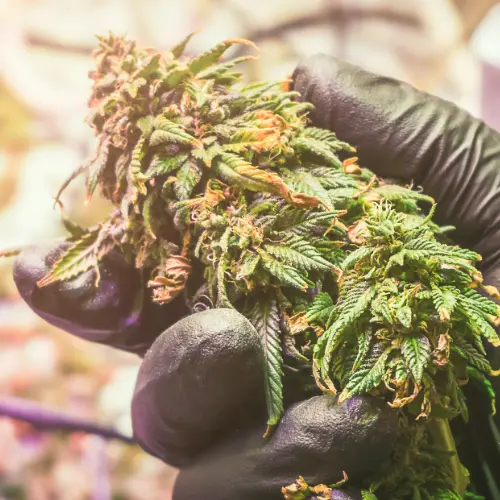The interest in cannabis as a harm reduction tool has surged in recent years, with increasing research supporting its potential to provide a safer alternative to traditional medications, particularly opioids. In 2024, a pivotal webinar series titled "Cannabis as an Alternative" was hosted, featuring notable experts like Dr. Marion McNabb and Dr. Peter Grinspoon. This article aims to offer a detailed recap of the series, presenting diverse perspectives and practical takeaways that highlight the evolving role of cannabis in harm reduction.
The Growing Role of Cannabis in Harm Reduction
Overview of the Webinar Series
The "Cannabis as an Alternative" series was meticulously designed to explore the multifaceted role of cannabis in modern medicine. Organized by the Cannabis Center of Excellence, the series brought together experts like Dr. Marion McNabb and Dr. Peter Grinspoon to discuss the latest research, clinical applications, and policy implications of cannabis as a harm reduction tool.
Age of Participants (N=586)
Veteran & Active Military Participants (N=586)
Self-identified race/ethnicity: (N=586)
Cannabis Center of Excellence
Under Dr. Marion McNabb’s leadership, the Cannabis Center of Excellence (CCOE) has spearheaded research and educational initiatives that deepen the understanding of cannabis's medical benefits. Dr. McNabb, with her extensive background in public health and cannabis research, has been instrumental in promoting evidence-based approaches to cannabis use in therapeutic settings. Supporting her in these efforts, Dr. Peter Grinspoon serves as the CCOE's Scientific Advisor, bringing his extensive clinical experience and personal advocacy to enrich the center's initiatives. Together, they guide the CCOE in its mission to bridge gaps between empirical evidence and practical healthcare applications, ensuring that the center remains at the forefront of cannabis research and education.

Key Insights from the Webinar
Clinical Recommendations and Studies
The recent webinar series cast a spotlight on groundbreaking studies that substantiate cannabis's role in mitigating the reliance on potentially more harmful substances, including opioids and alcohol. These studies provide a crucial scientific foundation, showing how cannabis can serve as an effective component in harm reduction strategies across various demographics. Dr. Marion McNabb, a key proponent of this research, has emphasized the importance of making these insights accessible to a broader audience. She highlighted the center's efforts in this regard, stating, "We have uploaded that video and several articles up so you can refer to that after this if you did not attend our first webinar." This statement not only underscores the commitment to disseminating knowledge but also invites ongoing engagement and education on the topic.
Dr. Grinspoon presented a comprehensive review of recent randomized controlled trials that assess the efficacy of cannabis in pain management, citing a specific 2024 study from the 'Journal of Clinical Pharmacology' that compared patient-reported outcomes in pain reduction between cannabinoid-based therapies and traditional opioids. He emphasized the need for personalized medicine approaches in cannabis prescriptions, supported by genetic markers and patient pharmacodynamic profiles.
The studies presented during the webinar series also addressed critical public health concerns, illustrating the potential of cannabis to reduce the harm associated with substance use disorders. By providing robust data and empirical evidence, the webinar aimed to equip healthcare providers, policymakers, and patients with the information needed to make informed decisions about incorporating cannabis into therapeutic practices.

Dr. Peter Grinspoon’s Perspectives
Dr. Peter Grinspoon, leveraging his extensive clinical experience and personal history, shared insights supported by his recent publication in the 'Journal of Cannabis Research' (Grinspoon, 2023), which investigates the efficacy of cannabis in chronic pain management across multiple patient demographics. As a seasoned physician and advocate for medical cannabis, Dr. Grinspoon has observed firsthand the therapeutic benefits of cannabis across a spectrum of clinical scenarios. He discussed these observations in the context of his latest book, "Seeing Through the Smoke," which provides a balanced view of cannabis, challenging many conventional notions while highlighting its potential benefits and limitations.

Sharing his clinical experiences, Dr. Grinspoon noted, "I've been treating people with medical cannabis for about 25 years now and it doesn't work for everybody, but it works for a lot of people, and it's been interesting and very helpful for my patients." This quote encapsulates the nuanced nature of cannabis treatment — acknowledging that while it is not a universal remedy, it offers substantial benefits for many patients, particularly those who have not found relief through traditional medical approaches.
Dr. Grinspoon elaborated on the multifaceted role of cannabis in clinical settings, discussing its application in pain management, its utility as a substitute for more addictive substances, and its potential to enhance quality of life for patients dealing with chronic conditions. His perspective, grounded in both personal recovery and professional practice, enriches the ongoing conversation about cannabis as a harm reduction tool, making a compelling case for its considered inclusion in holistic healthcare practices.
Practical Applications and Policy Implications
Cannabis in Pain Management
In the recent webinar, Dr. Peter Grinspoon provided an in-depth analysis of cannabis's role in pain management, particularly highlighting its potential to decrease reliance on opioids among patients suffering from chronic pain. This discussion is timely and increasingly relevant, especially considering the very recent rescheduling of cannabis to Schedule III by the DEA, a significant shift that occurred just a week after this webinar. This new classification acknowledges the medical utility of cannabis and reduces some regulatory burdens, which were substantial under its previous Schedule I classification.
Dr. Grinspoon explored various facets of cannabis use in pain management, from dosing strategies to patient outcomes. He explained how cannabis offers a dual benefit for pain sufferers: not only can it directly alleviate pain through its interaction with the endocannabinoid system, but it can also help mitigate the side effects associated with opioid use, such as dependency and withdrawal symptoms. These points were particularly underscored with patient case studies and ongoing clinical trials that suggest cannabis can be an effective part of a multimodal pain management strategy.
However, Dr. Grinspoon also addressed the challenges that have historically accompanied the integration of cannabis into standard medical practices. These include variability in dosing, the absence of standardized treatment protocols, and a general lack of awareness among healthcare providers about cannabis's potential benefits and uses. With the recent DEA rescheduling, there is optimism that more clinical research will help fill these gaps, leading to better, more consistent cannabis-based treatments.

Policy Development and Recommendations
The webinar series also shed light on the essential need for robust policy frameworks that can effectively support the integration of cannabis into healthcare systems. This is crucial for leveraging cannabis's full potential in clinical settings, especially now that its DEA Schedule III status acknowledges its therapeutic benefits. The experts discussed how this new scheduling could impact local and national policies, potentially simplifying the prescription process and making cannabis more accessible to patients who need it.
Before the rescheduling, cannabis faced numerous legal and administrative hurdles that made its integration into medical practice cumbersome and often unfeasible. These included restrictions on research, challenges in prescribing and dispensing, and a lack of coverage by insurance companies. The panelists highlighted ongoing efforts to advocate for policies that not only recognize cannabis's medical value but also support its safe and effective use.
The discussion also ventured into the implications of these policy changes for healthcare providers, patients, and insurers. With cannabis moving to a less restrictive DEA schedule, there is an anticipated increase in research funding and interest, which could lead to more robust clinical guidelines and better education for medical professionals about how and when to use cannabis in treatment regimens.
In closing, while the recent DEA rescheduling of cannabis marks a pivotal moment in its medical acceptance, the webinar made it clear that continued advocacy, research, and education are needed to ensure that cannabis is integrated thoughtfully and effectively into healthcare practices. This includes addressing existing disparities in access and ensuring that all patients can benefit from this promising treatment option.
Interactive Q&A Highlights
The webinar series excelled in fostering an interactive environment where audience engagement was a central component. A particularly dynamic aspect was the Q&A session, which allowed attendees to actively participate by voicing their concerns and seeking direct advice from experts like Dr. Marion McNabb and Dr. Peter Grinspoon. This exchange was invaluable for addressing common misconceptions about cannabis, such as doubts about its effectiveness, concerns about addiction, and uncertainties regarding legal issues, especially in light of the recent DEA rescheduling.
These discussions not only clarified factual information but also delved into personal experiences and anecdotal evidence, enriching the dialogue. The experts tackled a range of questions, from detailed inquiries about dosage and treatment protocols to broader queries about the future of cannabis in healthcare. This engagement underscored the public's growing interest and the need for clear, accessible information on the complexities of medical cannabis use.
Resources and Further Reading
Recognizing the importance of ongoing education in the rapidly evolving field of cannabis research, the webinar organizers provided a wealth of resources to support continued learning. Links to the webinar video, slide presentations, and a curated list of articles and research papers were made available to all participants. This repository of information is designed to serve not just as a reference but as a springboard for deeper exploration into the medical, legal, and social aspects of cannabis use.
Attendees were encouraged to share these resources within their networks and to engage in discussions via comments and social media platforms. This approach aimed to cultivate a community of informed individuals who are not only knowledgeable about cannabis but also active participants in shaping the discourse around it. By fostering such a community, the webinar series has contributed to a broader understanding and acceptance of cannabis, encouraging a more informed and respectful conversation on its role in society and medicine.
Together, these subsections highlight the webinar's commitment to education and engagement, recognizing that informed discussions and accessible resources are key to advancing the understanding of cannabis in medical and therapeutic contexts.
Medical and Legal Challenges
The discussions in the webinar series extensively covered the diverse perspectives within the medical community concerning the use of cannabis and the legal challenges that historically complicated its research and application. Different medical professionals, ranging from primary care physicians to specialists in pain management and psychiatry, often hold varied opinions based on their clinical experiences with patients. These differences underscore the need for a comprehensive, evidence-based approach to cannabis education in the medical field to foster a more uniform understanding and acceptance of its therapeutic potential.
Legal challenges, particularly those related to the previous Schedule I status of cannabis, which limited research opportunities and funding, were also a major focus. With the recent DEA rescheduling of cannabis to Schedule III, there is a newfound opportunity to address these challenges head-on. The experts discussed the importance of continuing advocacy efforts to ensure that this reclassification leads to meaningful changes that facilitate more extensive research and easier clinical application. They emphasized that through informed advocacy and continuing education, the medical community can better navigate these legal landscapes, ultimately leading to improved patient care and access to cannabis therapies.
Balancing Benefits and Risks
In an effort to present a balanced view, the webinar meticulously examined both the potential risks and benefits of using cannabis as a harm reduction tool. Experts like Dr. Peter Grinspoon provided insights into how cannabis can serve as a safer alternative to opioids for pain management, potentially reducing the incidence of addiction and other serious side effects associated with opioids. However, they also discussed the importance of recognizing and mitigating the possible risks associated with cannabis use, such as issues related to dosage control, potential psychological impacts, and the need for proper patient education.
The dialogue emphasized that while cannabis offers significant benefits, it requires a careful, personalized approach to maximize its therapeutic effects while minimizing potential risks. This includes proper patient assessment, ongoing monitoring by healthcare professionals, and adjusting treatments as needed based on individual patient responses and emerging research. The experts collectively highlighted the need for thorough medical guidance and patient education to ensure that cannabis is used effectively and safely as part of a broader treatment plan.
By providing an unbiased exploration of these topics, the webinar aimed to equip attendees with a well-rounded understanding of cannabis in harm reduction, encouraging healthcare providers to consider both the scientific evidence and patient-reported outcomes when integrating cannabis into their practice. This balanced approach ensures that both the potential benefits are leveraged, and the risks are responsibly managed, fostering a safe and informed therapeutic environment for all patients.
Let's Wrap Up the Cannabis as an Alternative Webinar Recap 2 of 3
This article has delved into the nuanced discussions and rich insights presented during the 2024 "Cannabis as an Alternative" webinar series. As the landscape of harm reduction continues to shift and evolve, the role of cannabis is becoming increasingly significant and complex. For healthcare providers, policymakers, and patients, remaining well-informed and actively engaged in these ongoing conversations is not just beneficial—it is essential for adapting to and shaping the future of healthcare.
In an era where the opioid crisis and other public health challenges demand innovative and effective solutions, the potential of cannabis as a harm reduction tool offers a promising horizon. However, as we embrace this potential, it is crucial to approach cannabis use with a balanced perspective, considering both its benefits and limitations. The insights shared by experts like Dr. McNabb and Dr. Grinspoon underscore the importance of education, research, and policy reform in fostering a safe and effective integration of cannabis into medical and therapeutic practices.
As the conversation around cannabis continues to evolve, it will undoubtedly raise new questions and challenges. By staying engaged and informed, the medical community and the public can ensure that the journey towards understanding and utilizing cannabis is marked by informed decisions, compassionate care, and rigorous scientific inquiry.
Glossary of Terms:
Harm Reduction: Strategies and ideas aimed at reducing the negative consequences associated with drug use.
Endocannabinoid System: A complex cell-signaling system identified in the early 1990s by researchers exploring THC, a well-known cannabinoid. It plays a role in regulating a range of functions and processes, including sleep, mood, appetite, memory, and reproduction and fertility.
OUD: Opioid Use Disorder: Opioid use disorder is a medical condition where individuals compulsively use opioids despite negative consequences. It is chronic and can lead to significant impairment in daily functioning. Symptoms include strong desire for opioids, difficulty controlling use, withdrawal symptoms, and continued use despite harm. Treatment involves medication, therapy, and support services.
Fact Box:
Reduction in Opioid Usage: Studies show that patients who use cannabis for pain management often reduce their opioid usage by up to 25%.
Chronic Pain Relief: Approximately 62% of people who use medical cannabis do so to help manage chronic pain.










































